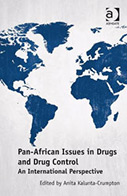Pan-African Issues in Drugs and Drug Control: An International Perspective

Editor: Anita Kalunta-Crumpton
Publisher: Farnham, Surrey, UK: Burlington, VT: Ashgate, 2015. 416p.
Reviewer: Joanne Csete | January 2016
The UN summit on control of illicit drugs to be held in April 2016 is a chance to revisit what many scholars and policy-makers regard as the failure of drug control policies that have sought complete prohibition of drug consumption, production, possession and marketing. Since the previous summit in 1998 — convened under the slogan “A drug-free world – we can do it!” – it has become clear by the UN’s own reckoning that a “drug-free world” is elusive if not impossible. Prohibitionist policies have not only failed to contain drug marketing and consumption, but also resulted in illegal markets run by organized criminal networks wreaking violence on communities, mass incarceration of non-violent drug offenders, exacerbation of HIV and hepatitis epidemics, demonization of people who are drug-dependent, and neglect of the health and social services that they need.
No region of the world has been exempt from the effects of illegal drug markets and of misguided policies to control them. In sub-Saharan Africa, heroin from East Asia and more recently Afghanistan has for decades transited through the functional but somewhat corrupt Indian Ocean ports of Kenya and Tanzania, eventually contributing to widespread drug injection that has fueled HIV. Until relatively recently, when Tanzania brought to significant scale a methadone treatment program for people who inject opiates, the answer to drug use in the region was harsh criminalization and virtually no health or social support or HIV prevention services for this population. West Africa has more recently become an important trafficking route for a number of illegal drugs, notably cocaine from South America destined for Europe; and drug-related health and social services are in extremely short supply.
Most sub-Saharan African countries have highly repressive drug laws that require or allow long prison sentences for drug use, small-scale possession, petty sale and other non-violent offenses, as well as for larger-scale trafficking. As transit of drugs and, inevitably, drug consumption have become more visible public policy challenges in the region, institutions such as the African Union and some policy-makers have begun to question the prohibitionist status quo, an important development in the lead-up to the UN drugs summit in 2016. The African Union’s five-year drug strategy and plan of action for 2013 to 2017 highlights the urgent need to stop treating drug dependence as a crime rather than as a health and social challenge, and enjoins member states to find alternatives to incarceration for minor drug infractions. This strategy stands in stark contrast to previous AU positions and has opened debates on approaches to drug policy that were unimaginable until relatively recently. In its 2014 report, the West African Commission on Drugs (WACD), a body of former heads of state and ministers convened by Kofi Annan and headed by former Nigerian president Olesegun Obasanjo, called for decriminalization of drug use and other minor offenses and for public health and human rights-oriented drug control. (Disclosure: I was a technical advisor to the WACD.) In South Africa and Ghana, for example, there is something of a public debate on decriminalization of minor drug offenses, especially those involving cannabis.
In view of these openings of drug policy debates, it would be useful to have a volume that would bring critical insights from African scholars to add to a growing global discussion on drug policy alternatives. The volume under review, edited by Anita Kalunta-Crompton, seeks to fill that niche as well as to explore the importance of drugs and drug policy for African populations in diaspora in the Americas and Europe.
Unfortunately, though the volume offers a few insightful chapters, it largely falls short of these goals. The chapters on the drug and drug policy situation in seven sub-Saharan countries – Cameroun, Kenya, Ghana, Nigeria, South Africa, Namibia and Zimbabwe – rely heavily on uncritically presented and often very old information about arrests, seizures of drugs by the police, and the letter of drug laws with little or no analysis of the kinds of questions about the impact of drug policy that are animating debates around the world. What have harsh drug laws meant for these countries, and what is the politics or the political economy of drug policy reform? How have the most marginalized people in society been affected by repressive policies and neglect of drug-related health and social services? How are countries responding to the new African Union strategy, which is not mentioned anywhere? Instead, sweeping present-tense statements are made based on very old information. (One certainly recognizes the problem of lack of recent data on drugs in Africa, something that also would have merited discussion.) Seizure data, which are very difficult to interpret, are consistently held out in this volume as though they were authoritative and straightforward.
Some of these chapters are more troubling than others. For example, scholars (including Gernot Klantschnig of the University of York, UK, and Axel Klein of the University of Kent), human rights organizations including Human Rights Watch, and Nigerian civil society groups, including recently Youth RISE-Nigeria, have reliably recounted repressive and abusive conduct on the part of agents of the Nigerian Drug Law Enforcement Agency (NDLEA) — particularly abuses in ostensible “treatment” facilities run by NDLEA that have been shown to be no better than prisons. No reference is made to any of these in the chapter on Nigeria, which includes much high praise of NDLEA as it “continues to sustain intensive and extensive coverage of all nooks and crannies of the country in the war on drugs.” Getting “treatment” for drug dependence and other health activities out of the hands of police is a major thread in the global drug policy reform discussion, but the “treatment and rehabilitation” activities of the NDLEA apparently do not raise any concern in this volume.
The chapter on Cameroun echoes the narrative of the U.S. government’s Drug Enforcement Administration (DEA) about the link between drugs and terrorism in West Africa. This narrative has been very useful for the U.S., especially the Pentagon, in the post-9/11 period to justify continued investment in military and paramilitary counter-narcotics operations. It has also been discredited repeatedly, including in the work of Wolfram Lacher of the German Institute for International and Security Affairs and more recently in investigative journalism reports such as that of Ginger Thompson in The New Yorker. These accounts have highlighted that some of the alleged “narco-terrorism” kingpins identified by the DEA have had tenuous links to terrorist organizations and virtually no real power in drug markets. Again, the degree to which drugs and terrorism are linked is a crucial point in international discussions of drug policy reform. The uncritical presentation in this volume is unhelpful.
The chapters on drugs and the African diaspora mostly do not fare much better, though the chapter on Canada is well argued and highlights that racism with regard to African Canadians emerged from a legacy of racist drug policy with respect to Chinese immigrants to Canada. The chapter on Mexico is puzzling, as it goes to great lengths to make the point that since less than 1% of the Mexican population is of African origin, there is not much to say about how this small minority is involved (or not) with drugs. The author then uses the concluding section of the chapter to argue against prohibitionist drug policy – an argument with which I am sympathetic – but the absence of any connection to the book’s Pan-African focus contributes to a lack of coherence in the volume. Another such factor is the discussion in some chapters of legal pharmaceutical products – not related to their non-medical use or to addiction issues — and agricultural chemicals. It is hard to know how these discussions relate to the book’s objective.
The failure of many of the country-focused accounts in this book to relate to large bodies of published literature is likewise unfortunate. The decriminalization of cannabis in Jamaica may have come too late to figure in the chapter on that country, but the debate around that change was widely studied and written about for years. It does not figure in the chapter in spite of the obvious importance to the racial dimensions of drug policy in that country. The chapter on the United States, written by the volume’s editor, makes little reference to the extremely large literature on race and the criminal justice system in the U.S. There are numerous authoritative accounts, including the well-known work of Michelle Alexander, of the long history of racism that made it easy for the Nixon administration and subsequent U.S. governments to fight a race war in the guise of a drug war. There are also many peer-reviewed studies showing that the social construction of a “crack baby” scare in the 1980s – the idea that the large numbers of “crack-addicted” children were being born in inner-city African American communities would burden health systems for generations – was completely unfounded. It is disappointing that in 2015, this author refers to “crack-addicted babies” as part of the “list of negative ramifications of Black drug use” rather than explaining the ways in which racist crack myths have undermined the reforms that would make U.S. drug policy more evidence-based and effective for all concerned.
Most of the authors whose work is featured in this volume use the unconventional term “drug use/abuse” (written in that way) to refer to drug consumption, perhaps a preference of the editor. Again, with respect to the opening of drug policy debates at this time in history, I find this term confusing and unhelpful. The failure to distinguish between harmful and less or non-harmful consumption of drugs is part of the challenge of drug policy reform. UN figures indicate that a relatively small percentage of people, around 10-11%, who consume drugs have problematic use (if that is what “abuse” refers to). But drug prohibition is energized by the false idea that all drug use is harmful. That all use is “abuse” also contributes to demonizing people who use drugs, and to moral judgments of them that undermine public health approaches. “Drug use/abuse” is not a standard term and is not explained in this book. Perhaps I misinterpret its intent – it seems to me to suggest an elision of the difference between use and abuse – but misinterpretation is inevitable without an explanation to help the reader.
The editor of this volume ends her consideration of the U.S. drug situation by noting: “Whether or not the popular U.S. drug prohibition approach is meeting the mission of the U.S. war on drugs is not of interest to this essay.” But it is precisely this factor that is the heart of drug policy discussions because prohibition has been such a useful policy framework for advancing a multitude of sins – including patently racist policies and practices. It is a missed opportunity that this volume has so much uncritical discussion of complex drug situations affecting Africans and people of African origin. Readers wanting a better introduction to this subject might start with Africa and the war on drugs by Carrier and Klantschnig (Zed Books, 2013).
Joanne Csete, PhD, MPH is adjunct associate professor at Columbia University and an independent consultant working frequently on drug policy.


